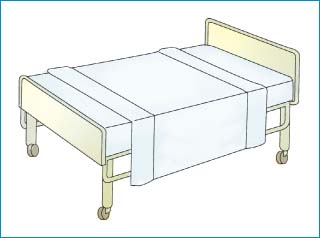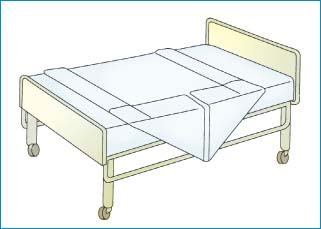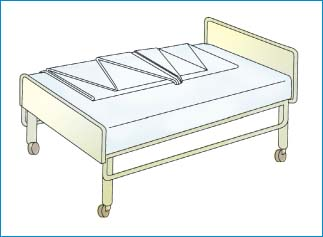Bedpan and Urinal Use
Bedpans and urinals permit elimination by a bedridden patient and accurate observation and measurement of urine and stool by the nurse. A bedpan is used by a female patient for defecation and urination and by a male patient for defecation; a urinal is used by a male patient for urination. Either device should be offered frequently, before meals, visiting hours, morning and
evening care, and any treatments or procedures. Whenever possible, allow the patient privacy.
evening care, and any treatments or procedures. Whenever possible, allow the patient privacy.
Making A Mitered Corner
To make a mitered corner, after placing the sheet on the bed, grasp the side edge of the sheet and lift it up to form a triangle.
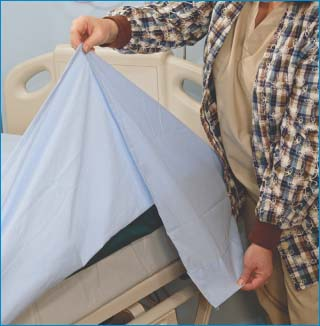
Then, place the sheet on the top of the bed, making a flat triangular fold.
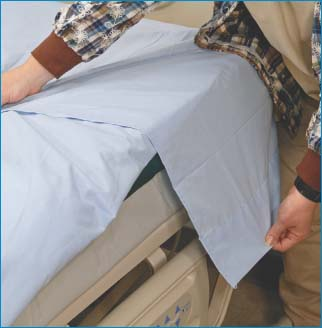
While holding the point of the triangle on the bed, tuck the sheet under the mattress.
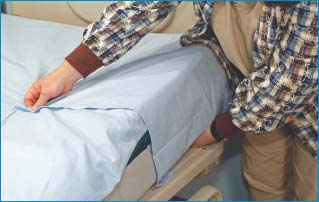
Take the triangular fold from the mattress and place it over the side of the mattress.
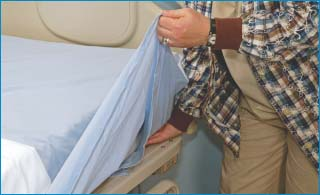
Tuck the remaining end of the triangular linen fold under the mattress.
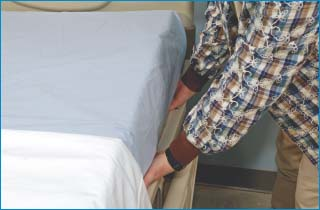 |
Making A Surgical Bed
Preparation of a surgical bed permits easy patient transfer from surgery and promotes cleanliness and comfort. To make such a bed, take the following steps:
Assemble linens as you would for making an unoccupied bed, including two clean sheets (one fitted, if available), a drawsheet, a bath blanket, a spread or sheet, a pillowcase, facial tissues, a trash bag, and linen-saver pads. Raise the bed to a comfortable working height to prevent back strain.
Slip the pillow into a clean pillowcase and place it on a nearby table or chair.
Make the foundation of the bed using the bottom sheet and drawsheet.
Place an open bath blanket about 15” (38 cm) from the head of the bed with its center fold positioned in the middle of the bed. The blanket warms the patient and counteracts the decreased body temperature caused by anesthesia.
Place a top sheet or spread on the bath blanket, and position it as you did the blanket. Then fold the blanket and sheet back from the top so that the blanket shows over the sheet. Similarly, fold the sheet and blanket up from the bottom (as shown in illustration 1).
On the side of the bed where you’ll receive the patient, fold up the two outer corners of the sheet and blanket so they meet in the middle of the bed (as shown in illustration 2).
Pick up the point hanging over this side of the bed and fanfold the linens back to the other side of the bed so the linens won’t interfere with patient transfer (as shown in illustration 3).
Raise the bed to the high position if you haven’t already. Then lock the wheels and lower the side rails. Make sure the side rails work properly. Move the bedside stand and other objects out of the stretcher’s path to facilitate easy transfer when the patient arrives.
After the patient is transferred to the bed, position the pillow for his comfort and safety. Cover him by pulling the top point of the sheet and blanket over him and opening the folds. After covering the patient, tuck in the linens at the foot of the bed and miter the corners.
To make the patient comfortable and to prevent unnecessary movement and linen changes, try to anticipate and be ready for his special needs. For nausea, keep an emesis basin, facial tissues, and linen-saver pads at the bedside. Also, remove all liquids from the bedside. If you expect bleeding or discharge, place one or more linen-saver pads on the bed.
Keep extra pillows handy to elevate arms and legs and to promote circulation, thereby preventing edema. If necessary, have IV equipment, suction apparatus, a roller for patient transfer, or other special equipment ready.
Get Clinical Tree app for offline access

